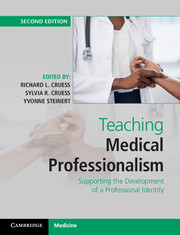Book contents
- Frontmatter
- Contents
- List of contributors
- Foreword
- Introduction
- Part I What is to be taught and learned
- Part II Theory
- Part III Principles
- 8 General principles for establishing programs to support professionalism and professional identity formation at the undergraduate and postgraduate levels
- 9 Faculty development to support professionalism and professional identity formation
- 10 Becoming interprofessional: professional identity formation in the health professions
- 11 Assessment of professionalism and progress in the development of a professional identity
- 12 Remediation of unprofessional behavior
- 13 Professional identity formation, the practicing physician, and continuing professional development
- 14 Professionalism, professional identity, and licensing and accrediting bodies
- Part IV Case studies in promoting professionalism and professional identity formation across the continuum
- Part V The future
- Index
- References
13 - Professional identity formation, the practicing physician, and continuing professional development
from Part III - Principles
Published online by Cambridge University Press: 05 April 2016
- Frontmatter
- Contents
- List of contributors
- Foreword
- Introduction
- Part I What is to be taught and learned
- Part II Theory
- Part III Principles
- 8 General principles for establishing programs to support professionalism and professional identity formation at the undergraduate and postgraduate levels
- 9 Faculty development to support professionalism and professional identity formation
- 10 Becoming interprofessional: professional identity formation in the health professions
- 11 Assessment of professionalism and progress in the development of a professional identity
- 12 Remediation of unprofessional behavior
- 13 Professional identity formation, the practicing physician, and continuing professional development
- 14 Professionalism, professional identity, and licensing and accrediting bodies
- Part IV Case studies in promoting professionalism and professional identity formation across the continuum
- Part V The future
- Index
- References
Summary
Mary is a fifty-year-old family physician who has worked for nearly two decades in a large suburban multidisciplinary family medicine clinic with eight other family physicians as well as nurses, pharmacists, and a dietician. Many of her patients and their families have been with her for several years. To better enjoy and support her children and aging parents, she has recently left the clinic to join a group of medical and radiation oncologists in a breast cancer clinic where she will be the only family physician providing primary care and counseling to their patients who don't have a family physician. She wonders how she will adapt to this work environment in which other family physicians are not available on location to discuss cases with and calibrate her work. She is feeling anxious about working exclusively with cancer physicians, given how specialized their work is, and she does not know any other family physicians who have assumed this type of a role in a specialty clinic.
John is a forty-six-year-old MD-PhD working in a medical school. He has just been promoted to professor in his medical school based on the quality of his work as judged by peers within the medical school and internationally. However, he struggles to combine clinical work, teaching, research, and committee work. He frequently works twelve to fourteen-hour days to fulfill the responsibilities of his various roles and succeeds partly by compartmentalizing his work. When he is on clinical service, he tries to focus on being a physician and clinician educator to the medical students and residents on his service. When he is in the lab, he tries to focus on his research, getting grants, running the lab and ensuring graduate students are making progress. As a professor, he is now expected to bring in larger, more complex grants from international agencies and to support postdoctoral fellows as well as graduate students. Many days are difficult as he finds himself pulled with questions from his lab or from the clinic when he is not there. Hospital meetings occur regularly and he is expected to actively participate in quality assurance committee work. Dealing with the new expectations associated with the promotion has been difficult; he feels pulled in too many directions and is not staying on top of his work.
- Type
- Chapter
- Information
- Teaching Medical ProfessionalismSupporting the Development of a Professional Identity, pp. 186 - 200Publisher: Cambridge University PressPrint publication year: 2016
References
- 1
- Cited by



